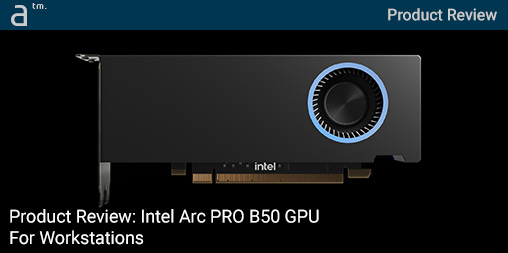THIS IS OUR FIRST TIME REVIEWING AN INTEL DISCREET professional-level GPU—the brand-new Intel Arc PRO B50. Powered by a new Xᵉ2 Architecture with large amounts of GDDR6 memory, the new Pro B50 offers a compelling entry-level or lower mid-tier workstation solution for computer graphics in CAD and 3D industries.
This new Intel GPU also delivers high performance on AI workloads as well as professional workstation 3D computer graphics. As AI increasingly infuses our common workloads, the Xᵉ2 GPUs on the Intel card feature dedicated AI hardware and matrix engines, known as Intel Xᵉ Matrix Extension (XMX). Each Vector Engine is paired with an XMX AI engine capable of 2048 FP16 ops/clock and 4096 INT8 ops/clock.
General Introduction
For our Architosh readers, we have focused on AEC/O application workloads rather than AI performance workloads. Readers are advised to refer to this and this for additional information on the B50’s performance characteristics for AI workloads.

Intel Arc PRO B50 is an SFF, Dual-Slot workstation-class GPU with impressive performance characteristics and excellent value, priced at an MSR of 349.00 USD.
We reviewed our Intel Arc PRO B50 on our trusty BOXX APPEX E3 workstation running the Windows 10 Professional operating system. This is the same exact rig and setup as all our past GPU card reviews, dating back to the AMD Radeon Pro W6600 GPU in the fall of 2021. The Intel GPU is priced at 349.00 USD (suggested retail price).
For purposes of direct comparison, we also tested an NVIDIA RTX A1000 GPU, which sells for between 404 and 508.00 USD (in other words, similarly priced). We will use these prices (using the lower number) for the purposes of our GPU economics charts and calculations (see page 3). In other words, when we compute performance on a per-dollar basis between the Intel Arc PRO B50 and the NVIDIA RTX A1000 reference card, we will use 404 USD for the calculations on the Nvidia side.
GPU Details: Intel Arc PRO B50
The B50 is a small form-factor (SFF) dual-slot GPU card that boasts 16 GB of GDDR6 memory, which is twice the amount provided by the Nvidia RTX A1000 reference GPU. Built on the new Xᵉ2 Architecture, the BMG-G21 GPU provides excellent performance across AAA games, workstation graphics, and running ML/AI workloads. Key details include:
- 128 Xᵉ Vector Engines
- 128 XMX Matric Engines
- 16 Ray Tracing Units
- 170 TOPS (INT8)
- TSMC N5 node (19.6 B / 272mm2)
- PCI Express x8 Gen5 (x16 Physical)
- OpenGL 4.6 / Vulkan 1.4 / DirectX 12 Ultimate / OpenCL 3.0
- 16 GB GDDR6
- 224 GB/s memory bandwidth
- 4 Displays (up to 8K120 HDR) (DisplayPort 2.1) (4X 4K120 HDR)
- Up to 7680×4320 @ 60Hz (DisplayPort 2.1)
- 70W max power consumption (no auxiliary power needed)
- SFF, Dual Slot
- VR Ready
The Intel BMG-GPU SoC (System on a Chip) is illustrated in the image at the bottom of the page. Click on the image for a larger view to see details of the chip design.
New Design and Chip Architecture
The Intel Arc PRO B50 is a discrete GPU card built by Intel, and the famed semiconductor company says it has taken feedback from its A-series customers and redesigned the platform and thermal solution, improving efficiency and acoustics. In our own testing, we were impressed with how quiet the unit was under multiple testing scenarios and general usage.

The Intel Arc PRO B50 is installed in our BOXX testing workstation. The SFF, Dual-slot GPU card does not require auxiliary power and runs from the PCIe slot itself. The overall installation and setup of both the card and the driver software were straightforward.
The actual GPU card is striking visually, with Intel’s signature blue being incorporated as accents and on an entire side of the CPU. As for the new compute architecture, the updated second-generation Xᵉ2 Architecture features a wider SIMD16 width for improved efficiency and compatibility, as well as a 33% larger L1 cache with a total capacity of 256 KB. The Ray Tracing Units are also second generation in this B50 GPU, and the benchmarks and visuals during testing attest to the strength of Intel’s GPU solution.

A side-view of the Intel Arc PRO B50 GPU card. Intel redesigned the thermal architecture in this B-series version.
In fact, for AEC workloads, which we focus on here at Architosh, the rendering performance of the Intel Arc PRO B50 makes this GPU a surprisingly good choice for lower-tier workstations. But we are jumping ahead of ourselves, but you will see it in the benchmarks we provide below (we do all of our testing ourselves).
Since benchmark performance is where the rubber meets the road, let’s go to the next page to see how Intel’s latest professional GPU card stacks up against its primary Nvidia competitor and even some previously reviewed GPU cards and SoCs.
next page: Benchmarking and Performance Results







